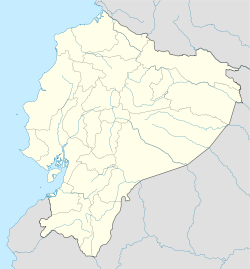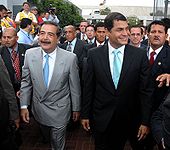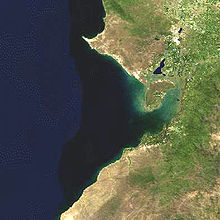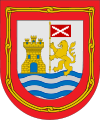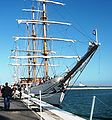- Guayaquil
-
This article is about the city of Guayaquil. For the canton named after this city, see Guayaquil (canton).
Guayaquil From top left to right: The United Nations Statue, Estadio Monumental Banco del Pichincha; Las Peñas, IMAX Malceon 2000, and the Guayas River Bridgewalk. 
Flag
SealNickname(s): La Perla del Pacífico
English: The Pearl of the PacificMotto: Por Guayaquil Independiente Coordinates: 2°11′S 79°53′W / 2.183°S 79.883°WCoordinates: 2°11′S 79°53′W / 2.183°S 79.883°W Country Ecuador Province Guayas Canton Guayaquil Settled 1547 Independence 1820 Government – Mayor Jaime Nebot – Vice-Mayor Domenica Tabacchi Area – Total 133.01 sq mi (344.5 km2) – Land 122.17 sq mi (316.42 km2) – Water 10.84 sq mi (28.08 km2) Elevation 13.2 ft (4 m) Population (2009[1]) – Total 2,634,000 – Density 19,547.40/sq mi (7,547.16/km2) Time zone ECT (UTC-5) Website www.guayaquil.gov.ec Guayaquil (pronounced: [ɡwaʝaˈkil]), officially Santiago de Guayaquil (pronounced: [sanˈtjaɣo ðe ɣwaʝaˈkil]), is the largest and the most populous city in Ecuador,with about 2.3 million inhabitants in the city and nearly 3.1 million in the metropolitan area, as well as that nation's main port. The city is the capital of the Ecuadorian province of Guayas and the seat of the namesake canton.
Guayaquil is located on the western bank of the Guayas River, which flows into the Pacific Ocean at the Gulf of Guayaquil. Because of its location, the city is the center of Ecuador's business and manufacturing industries.
Contents
History
Guayaquil was founded on July 25, 1538[2] with the name Muy Noble y Muy Leal Ciudad de Santiago de Guayaquil (Most Noble and Most Loyal City of St. James of Guayaquil) by Spanish Conquistador Francisco de Orellana. Even before it was founded by the Spanish, it already existed as a native village.
In 1600 Guayaquil had a population of about 2,000 people; by 1700 the city had a population of over 10,000.
In 1687, Guayaquil was attacked and looted by English and French pirates under the command of George d'Hout (English) and Picard and Groniet (Frenchmen). Of the more than 260 pirates, 35 died and 46 were wounded; 75 defenders of the city died and more than 100 were wounded. The pirates took local women as concubines.
In 1709, the English captains Woodes Rogers, Etienne Courtney, and William Dampier along with 110 other pirates, looted Guayaquil and demanded ransom; however, they suddenly departed without collecting the ransom after an epidemic of yellow fever broke out.
On October 9, 1820, almost without bloodshed, a group of civilians, supported by soldiers from the "Granaderos de Reserva", a battalion quartered in Guayaquil, overwhelmed the resistance of the Royalist guards and arrested the Spanish authorities. Guayaquil declared independence from Spain, becoming Provincia Libre de Guayaquil, and José Joaquín de Olmedo was named Jefe Civil (Civilian Chief) of Guayaquil. This would prove to be a key victory for the Ecuadorian War of Independence.
On July 26, 1822, José de San Martín and Simón Bolívar held a famous conference in Guayaquil to plan for the independence of Spanish South America.
In 1829, the city was invaded by the Peruvian Army, which occupied it for seven months.
In 1860, the city was the site of the Battle of Guayaquil, the last of a series of military conflicts between the forces of the Provisional Government, led by Gabriel García Moreno and General Juan José Flores, and the forces of the Supreme Chief of Guayas, General Guillermo Franco, whose government was recognized as possessing sovereignty over the Ecuadorian territory by Peruvian president Ramón Castilla.
Large portions of the city were destroyed by a major fire in 1896.
On July 8, 1898, the Guayaquil City Hall "Muy Ilustre Municipalidad de Guayaquil" officially recognized the anthem written by José Joaquín de Olmedo in 1821, with the music composed by Ana Villamil Ycaza in 1895, as the "Himno al 9 de Octubre" Canción al Nueve de Octubre, most widely known now as the "Himno a Guayaquil" (Guayaquil Anthem).
Guayaquil at present
Present-day Guayaquil continues its tradition of trade, although the city is expanding its tourism base, by beautifying the city.[citation needed] This process has taken years, comprising the last two municipal administrations, who succeed in turning Guayaquil into a national and international tourist destination. It is now a headquarters for fairs and international events.[citation needed]
Economy
Guayaquileños' main sources of income are: formal and informal trade, business, agriculture and aquaculture. Most commerce consists of small and medium businesses, adding an important informal economy occupation that gives thousands of guayaquileños employment.[3] Despite this, Guayaquil is the city with the highest rate of underemployment (about 40% of the economically active population) and unemployment (about 11% of the economically active population) of Ecuador.[citation needed]
Guayaquil maintains an infrastructure for import and export of products with international standards. Among its major trading points are the Seaport, the largest in Ecuador and one of the biggest influx of shipping on the shores of the Pacific and José Joaquín de Olmedo International Airport. Additionally, it has an infrastructure of roads to other cities and provinces, which are considered among the best in the country.
On going projects seek urban regeneration as a principal objective to the growth of the city's commercial districts, as the increase of capital produces income. These projects in the city driven by the recent mayors have achieved this goal after investing large sums of money. The current municipal administration aims to convert Guayaquil into a place for first-class international tourism and business multinationals.[4]
Climate
Guayaquil features a tropical savanna climate. The climate is hot and generally humid throughout the year with little variation in average temperatures. Rainfall is heavy between January and April, during el Nino years rainfall may increase dramatically and flooding usually occurs. Typically however, rainfall is minimal from May until mid December due to the cooling influence of the Humboldt Current.
Climate data for Guayaquil Month Jan Feb Mar Apr May Jun Jul Aug Sep Oct Nov Dec Year Average high °C (°F) 31
(88)31
(87)32
(89)32
(89)31
(87)29
(85)29
(84)29
(84)30
(86)29
(85)30
(86)31
(88){{{year high C}}}
(86)Average low °C (°F) 23
(74)24
(75)24
(76)24
(75)23
(74)22
(72)21
(70)21
(69)21
(70)22
(71)22
(72)23
(73){{{year low C}}}
(72)Precipitation mm (inches) 223.7
(8.807)278.4
(10.961)287.3
(11.311)180.0
(7.087)53.2
(2.094)16.8
(0.661)1.9
(0.075)0.3
(0.012)1.6
(0.063)2.8
(0.11)3.0
(0.118)29.7
(1.169)1,080.0
(42.52)Source no. 1: Weatherbase[5] Source no. 2: WMO[6] Government
Guayaquil's current mayor is Jaime Nebot, a well-known member of the political party Partido Social Cristiano. Jaime Nebot began a campaign of construction projects for the city in the late 1990s to attract tourism, that included the "urban regeneration", which reconstructed the city in all levels including sidewalks, parks, sewer system, it took the power and telephone lines underground, it saw a lot of reconstruction of the city's chaotic transit system with the construction of multiple infrastructures (streets, speedways, overhead passages, tunnels, etc.).[citation needed]
In August 2006, the city's first bus rapid transit system, Metrovia, opened to provide a quicker, high-capacity service. One of the main projects was called Malecón 2000 [maleˈkon doz ˈmil], the renovation of the promenade (malecón) along the Guayas River with the addition of a boardwalk in 2000. Another project was the creation of the Nuevo Parque Histórico, a park in a housing development area that is called Entre Ríos because it lies between the Daule and Babahoyo rivers (which confluence to form the Guayas river), in a mangrove wetland area. The park cost the city about 7 million dollars.
Geography
Guayaquil, Ecuador, the nation's largest city and the capital of Guayas Province. It is on the Guayas River about 40 miles (64 km) north of the Gulf of Guayaquil, near the Equator. Guayaquil is Ecuador's chief port and principal commercial and manufacturing center. An international airport and the only railway to the nation's interior serve the city.
Landmarks include the cathedral and the church of San Francisco. Among educational institutions are the University of Guayaquil (founded in 1867) and the Catholic University of St. James (1962).
Guayaquil city sectors
Guayaquil City Territorial Organization
Number of the sector in reference with the City Map# Sectors # Sectors # Sectors 1 9 de Octubre Este 25 Febres Cordero 49 Prosperina 2 9 de Octubre Oeste 26 Floresta 50 Puerto Azul Norte 3 Abel Gilbert 27 La Florida 51 Puerto Azul Sur 4 Acuarela 28 García Moreno 52 Puerto Lisa 5 Los Álamos 29 Garzota 53 Quinto Guayas Este 6 Alborada Este 30 Guangala 54 Quinto Guayas Oeste 7 Alborada Oeste 31 Guasmo Este 55 Río Guayas 8 Los Almendros 32 Guasmo Oeste 56 Roca 9 Las Américas 33 Huancavilca 57 Rocafuerte 10 Atarazana 34 Isla Trinitaria 58 La Saiba 11 Ayacucho 35 Kennedy 59 Samanes 12 Bastión Popular 36 Letamendi 60 San Eduardo 13 Batallón del Suburbio 37 Luz del Guayas 61 Los Sauces 14 Bellavista 38 Mapasingue 62 Simón Bolívar 15 Bolívar 39 Miraflores 63 Sopeña 16 Los Ceibos 40 Monte Bello 64 Sucre 17 Centenario 41 Olmedo 65 Tarqui 18 Cerro del Carmen 42 Las Orquidias Este 66 Unión 19 Cóndor 43 Las Orquidias Oeste 67 Urdenor 20 Cuba 44 Paraíso 68 Urdaneta 21 Del Astillero 45 Pascuales 69 Urdesa 22 Estero Salado 46 Pedro Carbo 70 Los Vergeles 23 Los Esteros 47 Las Peñas 71 Ximena 24 La FAE 48 La Pradera 72 Mirador Norte Demographics
Historical Populations Guayaquil City
Compared with Guayas Province, Canton of Guayaquil, and Guayaquil City[7]Census Guayas Province Canton of Guayaquil Guayaquil City 1950 582,144 331,942 258,966 1962 979,223 567,895 510,804 1974 1,512,333 907,013 823,219 1982 2,038,454 1,328,005 1,199,344 1990 2,515,146 1,570,396 1,508,444 2001 4,509,034 2,148,779 1,985,379 Source: Instituto Nacional de Estadisticas y Censos Percentage Population Growth of Guayaquil City
Compared with Guayas Province, Canton of Guayaquil, and Guayaquil City.[7]Census Guayas Province Canton of Guayaquil Guayaquil City 1950–1962 4.34% 4.49% 5.67% 1962–1974 3.77% 4.06% 4.14% 1974–1982 3.52% 4.50% 4.44% 1982–1990 2.63% 2.10% 2.87% 1990–2001 2.49% 2.38% 2.50% Source: Instituto Nacional de Estadisticas y Censos Food
Typical Guayaquil cuisine includes mostly seafood dishes such as encebollado and ceviche. The most traditional dish of Guayaquil is Arroz con Menestra y Carne Asada (Rice with lentils and grilled beef).[8] Churrasco is also a staple food of Guayaquil.
During breakfast, Patacones and Bolon de Verde (fried plantain with cheese mashed and given a rounded shape) play a big role. Pan de yuca is a typical snack in Guayaquil. Local cuisine is heavily influenced by the diversity of Guayaquil's ethnic groups which includes Italian, Brazilian, African, East Asian and Middle Eastern origins.[citation needed]
Notable people
Artists
Ecuador is known for its artists and its place in art history. Many of them were born in Guayaquil, such as:
- Félix Arauz (b. 1935, Guayaquil)
- Xavier Blum Pinto (b. 1957, Guayaquil)
- Luis Burgos Flor (b. 1939, Guayaquil)
- Theo Constanté (b.1934, Guayaquil)
- Araceli Gilbert (b. 1913, Guayaquil – d. 1993, Quito)
- Julio Jaramillo (b. 1935, Guayaquil – d. 1978, Guayaquil)
- Luis Miranda (b. 1932, Guayaquil)
- Luis Molinari (b. 1929, Guayaquil)
- Enrique Tábara (b. 1930, Guayaquil)
- Jorge Velarde (b. 1960, Guayaquil)
- Juan Villafuerte (b. 1945, Guayaquil; d. 1977, Barcelona, Spain)
Others
Other notable people from Guayaquil include:
- Frederick Ashton, choreographer and dancer
- Novelist Demetrio Aguilera Malta
- Animator Mike Judge
- Poets José Joaquín de Olmedo,[9] Karina Galvez[10] and Adalberto Ortiz
- Writer/historian Jenny Estrada
- color commentator for the WWE Spanish team and former professional wrestler Hugo Savinovich
- Dancer and choreographer Frederick Ashton
- Scholar Benjamín Urrutia
- Former world's oldest person María Capovilla
- Violinist Alex Jimbo Viteri
- Violinist Jorge Saade
- Actor Albert Paulsen
- Operatic soprano Beatriz Parra Durango
- rapper Gerardo Mejia, made famous during the early 90s for his song "Rico Suave"
- Tennis player Pancho Segura who in 1950 and 1952 was the world's Co-No. 1 player
- Tennis player Andrés Gómez, who won the ATP Championship of Roland Garros in Paris, France in 1990
- Swimmer Jorge Delgado 4th in the 1972 Munich Olympic Games, multiple times South American champion (19), Gold Medal 1975 Panamerican champion.
- Striker Felipe Caicedo, Sporting Lisbon
Religious buildings
As in many other cities from Ecuador, Guayaquil inherited the catholic organization from the colonial Spanish times and was divided in parishes. Nonetheless, many of the original religious and historic buildings tied to those parishes were destroyed by fires and the attack of English, French, and Dutch pirates. Today, very few remains of religious colonial architecture are present and in all cases have been altered without preserving their originality. The oldest church of Guayaquil, rebuilt many times though, is the "Iglesia de Santo Domingo".
Guayaquil has a cathedral and many other Roman Catholic churches. Approximately 80% of Guayaquileños are Catholics, however, several Protestant groups are also present, such as the Evangelical Church with about 150,000 members.
Many other faiths and religions are represented throughout the city. There are a temple and many chapels of the Church of Jesus Christ of Latter-day Saints. There is a small Jewish community, composed mostly of Israeli citizens, and German immigrants who fled Germany during the Second World War. Guayaquil is home to the only Messianic synagogue in coastal Ecuador.
Education
Biblioteca Municipal de Guayaquil (Municipal Library of Guayaquil) serves as the public library of Guayaquil.[11]
Sports
There are two major soccer clubs; the Barcelona Sporting Club and the Club Sport Emelec. Both clubs have their own stadiums; the Estadio Monumental Isidro Romero Carbo is the home of the "Barcelonistas" while the Estadio George Capwell is the home of the "Emelecistas". These two teams have a long history of rivalry in Guayaquil and when these two teams play against each other the game is called "El Clásico del Astillero". (Emelec is short for "Empresa Electrica del Ecuador" – the team was sponsored by the electric power company when founded.)
The city is the home of Andrés Gómez and Nicolás Lapentti, Ecuador's two most famous tennis players, now both retired. The "Abierto de Tenis Ciudad de Guayaquil" is a tennis tournament organised in Guayaquil by Gómez and Luis Morejon, and held annually in November.
Another major event in the city is the Guayaquil Marathon, organised by DM3, which is held every year on the first weekend of October since 2005. These race is certified by the (AIMS) Association of International Marathons and Distance Races.
Universities
Some of Guayaquil's main universities are:
- Escuela Superior Politecnica del Litoral ESPOL
- Universidad de Especialidades Espíritu Santo UEES
- Universidad de Guayaquil
- Universidad Católica de Santiago de Guayaquil
- Universidad Laica Vicente Rocafuerte
- Universidad Casa Grande
- Universidad Santa Maria
- Blue Hill College
- Brookdale Community College
- Universidad Del Pacífico UPACIFICO
- IGACD-Institute of Graphics Arts and Digital Science
Notable places
The Malecón 2000 is a restoration project of the historic Simón Bolívar Pier. It will be a symbolic centre of the city, a mix of green areas and shopping. The tall ship Guayas has its home base here.
The Palacio Municipal is located in front of the Malecón and holds the political offices of city and provincial officials. Built in a neoclassical style, it is considered one of the most important architectural works in the country.
Las Peñas is a neighbourhood in the northeast corner of the city centre; is the artistic centre of the city. Many of the area's 400-year-old houses have been converted into art galleries and several notable artists have studios in the area.
The Mercado Artesanal is the largest artisan market in the city. The market is housed in a 240-shop building that takes up the entire block of Baquerizo Avenue, between Loja and Juan Montalvo streets. Its many vendors sell indigenous crafts, jewellery, and paintings.
Parque Centenario is located on 9 de Octubre street, between Lorenzo de Garaycoa and Pedro Moncayo. This is the largest park in the town centre, occupying four city blocks. It offers shady refuge from the equatorial sun, with large trees arching over the walkways and lawns. A large Statue of Liberty dominates the central area of the park.
Parque Seminario (also known as Parque de Las Iguanas or Iguana Park) located on 10 de Agosto Avenue and Chile Avenue, is home to many iguanas, some of which approach 5 feet in length. Tourists and locals alike often feed the iguanas mango slices from park vendors. There is also a pond filled with colourful Japanese Tilapia. An equestrian statue of Simón Bolívar is located in the centre of the park.
Urdesa is a traditional neighborhood, for restaurants, stores.
Bahia is a popular marketplace for toys, clothing, electronic goods, DVDs, and CDs.
The city's new airport, José Joaquín de Olmedo International Airport (IATA airport code: GYE), though using the same runways, had its passenger terminal completely rebuilt in 2006 and was renamed. The old passenger terminal, Simon Bolivar, is now a convention centre.[12]
Sister cities
Guayaquil has city partnerships with the following cities and/or regions:
 Miami, Florida, USA
Miami, Florida, USA Shanghai, People's Republic of China (2001)[citation needed]
Shanghai, People's Republic of China (2001)[citation needed] Santiago, Chile
Santiago, Chile Concepción, Chile
Concepción, Chile Houston, Texas, USA (1987)
Houston, Texas, USA (1987) Genoa, Italy
Genoa, Italy Barcelona, Spain
Barcelona, Spain Bogotá, Colombia
Bogotá, Colombia Haifa, Israel
Haifa, Israel
Photos
-
Spanish Colonial shield of the city and government.
-
Monument depicting the meeting between Simón Bolívar and José de San Martín for the independence of South America.
-
Branch of the Ecuadorian Central Bank (Banco Central del Ecuador or BCE) in Guayaquil.
-
The Guayas river flows next to downtown Guayaquil.
See also
- List of urban parishes in Guayaquil
- José Joaquín de Olmedo International Airport
References
- ^ CIA World Factbook. CIA, 2011.
- ^ July 25th, is a legal holiday in Guayaquil. Historians have not yet reached a consensus about the date of Guayaquil's foundation or founder. The city might have been founded more than once. Another possible founder might be Diego de Almagro.
- ^ Guayaquil y como el mercado siempre aparece: El retorno de los ‘informales’, Diario Expreso
- ^ Proyecto de Regeneración Urbana de Guayaquil, artículo «¿Por qué Guayaquil requería regeneración urbana?» de la M. I. Municipalidad de Guayaquil
- ^ "Climate information for Guayaquil in Ecuador". Weatherbase. September 2011. http://www.weatherbase.com/weather/weather.php3?s=30248&refer=&units=us&cityname=Guayaquil-Guayas-Ecuador. Retrieved September 28, 2011.
- ^ "GUAYAQUIL/SIMON BOLIV, ECUADOR - Guayaquil". http://www.worldclimate.com/cgi-bin/data.pl?ref=S02W079+2100+84203W.
- ^ a b Evolución de la población de la provincia, Cantón Guayaquil, y de la Ciudad de Guayaquil – Guayas, Censo 2001, Según el Instituto Nacional de Estadisticas y Censos
- ^ achnolt. "El orgullo del pais es la musica". YouTube. http://www.youtube.com/watch?v=IRoppPuR6Js. Retrieved April 17, 2010.
- ^ "Canción al Nueve de Octubre – Wikipedia, the free encyclopedia". En.wikipedia.org. March 25, 2010. http://en.wikipedia.org/wiki/Canci%C3%B3n_al_Nueve_de_Octubre. Retrieved April 17, 2010.
- ^ http://www.karinagalvez.com/attachments/056_ESE%20SU%20GUAYAQUIL%20VIEJO.pdf
- ^ "Inicio." Biblioteca Municipal de Guayaquil. Retrieved on April 7, 2009.
- ^ http://www.expoguayaquil.com/quienes_somos/ubicacion.aspx
External links
- Municipalidad de Guayaquil
- Guayaquil at Google Maps
- Barrio De Paz – A documentary about gang culture in Guayaquil on OneWorldTV
Provincial capitals in Ecuador Within regions, north to southInsular Costa Sierra Oriente Categories:- Populated places in Guayas Province
- Populated coastal places in Ecuador
- Guayaquil
- Guayaquil (canton)
- Port cities in Ecuador
- Province capitals in Ecuador
- Populated places established in 1538
Wikimedia Foundation. 2010.


